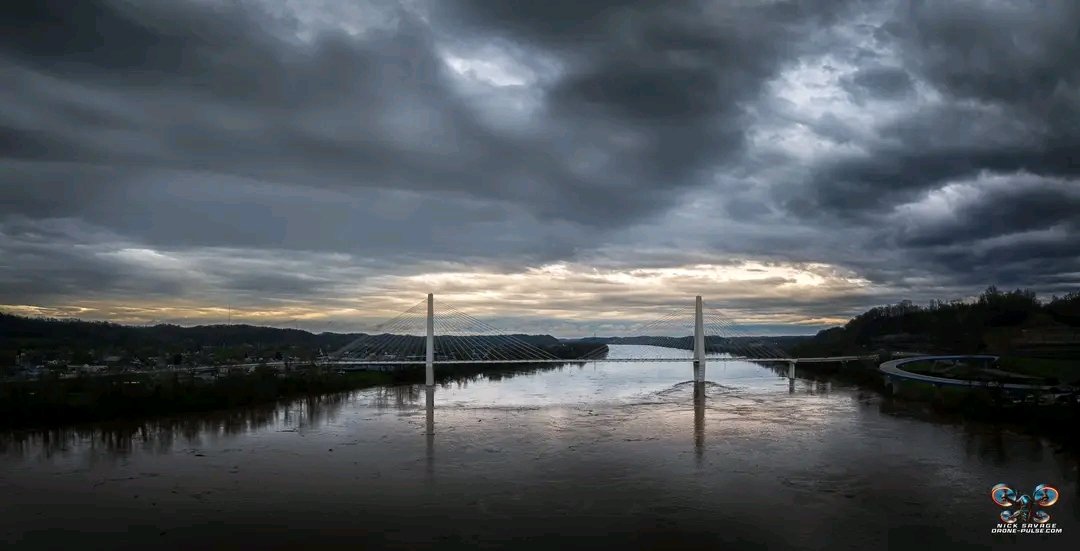**The Rising Fury of the Ohio River: A Community Braces for Flooding**
The water is really moving already. You can hear it—the churn of the current, the groaning of the river as it swells beyond its banks. The sound of debris slamming into the river markers echoes like distant thunder, a relentless reminder of the power surging through the Ohio River. With the river projected to crest at 55.3 feet between April 7 and 8, just inches below the major flood stage of 56 feet, communities along its banks are holding their breath, preparing for what could be the most significant flooding event in years.
The Ohio River has always been a lifeline for the towns and cities that dot its course, a vital artery for trade, transportation, and recreation. But when the waters rise, that same river becomes a force of destruction, swallowing roads, inundating homes, and testing the resilience of those who live in its shadow. Right now, the river is in motion—swift, unrelenting, and carrying with it the remnants of upstream storms: broken branches, scattered trash, and the occasional twisted remains of structures torn loose by the current. The river markers, usually steady guides for boaters, now shudder under the impact, their metal frames ringing out with each collision.
For those who have lived here for decades, the signs are familiar. The smell of wet earth mixing with the faint metallic tang of floodwater. The way the river seems to breathe, expanding outward, creeping into places usually untouched by its reach. Sandbags are appearing along low-lying streets, and emergency crews are on standby, watching the forecasts, knowing that even a few extra inches of rain could push the river over the edge into major flooding. At 55.3 feet, the water will already be lapping at doorsteps, cutting off roads, and forcing evacuations in the most vulnerable areas. If it climbs just a little higher—to that 56-foot major flood stage—the damage could escalate dramatically.
The science behind river flooding is both precise and unpredictable. Hydrologists can calculate crest projections based on upstream rainfall, snowmelt, and the capacity of tributaries, but nature always has the final say. The Ohio River’s watershed spans multiple states, meaning heavy rains in Pennsylvania or West Virginia can translate into rising waters in Kentucky and Indiana days later. Right now, the combination of saturated ground and recent storms has set the stage for this surge. The river is already high, and the crest is still coming.
For residents, the waiting is the hardest part. Some remember the floods of 1997 or 2018, when the river swallowed whole neighborhoods, leaving behind mud-caked ruins and shattered lives. Others are new to the area, unprepared for the way a flood can rewrite the landscape in a matter of hours. Business owners in flood-prone districts are moving inventory to higher ground, while farmers are scrambling to protect livestock and equipment. The tension is palpable—a mix of resignation and defiance. People here know the river’s moods, but that doesn’t make it any easier when the water comes knocking.
Emergency management teams are in constant communication, coordinating with the National Weather Service and local agencies. Flood warnings have been issued, and shelters are on standby in case evacuations become necessary. Social media feeds are filled with updates—road closures, sandbagging locations, pleas for volunteers. In times like these, community becomes everything. Neighbors help neighbors, strangers become allies, and the shared threat of the rising water erases, at least temporarily, the usual divisions.
There’s an eerie beauty to a river at flood stage. The way it transforms familiar landscapes into something unrecognizable—streets become canals, parking lots turn into ponds, and playgrounds vanish beneath the brown, swirling water. But beneath that surreal spectacle is the raw danger of fast-moving currents, hidden debris, and the risk of contamination as sewage systems back up and chemicals leach into the floodwaters. It’s not just the immediate inundation that’s a problem; it’s the aftermath—the mold, the structural damage, the long, exhausting recovery.
As the Ohio River approaches its projected crest, the next 48 hours will be critical. Will it stop just short of major flood stage, or will some unexpected rain push it over? For now, all anyone can do is watch, prepare, and hope. The river doesn’t care about human plans. It moves as it always has, obeying gravity and weather, indifferent to the lives it disrupts.
And when the waters finally recede, as they always do, the cleanup will begin. The mud will be shoveled out, the repairs will start, and life will slowly return to normal—until the next time the river rises. Because in the end, the Ohio River is eternal. It was here long before the towns along its banks, and it will be here long after. The people who live beside it know this. They respect its power, even as they rebuild in its shadow.
For now, all eyes are on the forecast, the river gauges, and the sound of debris hitting those metal markers—a steady, ominous drumbeat counting down to the crest.





